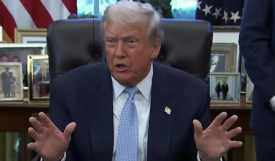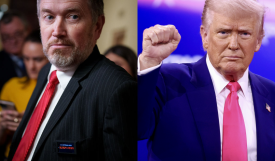Uber Kidnapping: Passenger Says Driver Ran From Authorities While Driving Him
A business traveler was taken for an Uber ride that he'll never forget. That's because he claimed the driver took him on a high-speed ride while trying to evade authorities.
The whole thing took place Tuesday afternoon in Washington, D.C. Ryan Simonetti was on a business trip for his company Convene. He wanted to catch a ride from 7th and F Streets NW to the company's new offices in Tysons Corner.
Simonetti is a "die-hard Uber fan" and uses the services frequently. Uber is a car-hailing service that uses smartphone apps and GPS technology to match passengers with drivers. The driver who picked up Simonetti was an UberBLACK driver. UberBLACK drivers are supposed to be licensed chaffeurs in black sedans or SUVs.
Simonetti requested the ride on his smartphone and the Uber driver arrived. He and his two colleagues saw that the driver was being questioned by a D.C. taxi inspector.
Simonetti got into the car. He sat in the front seat, and his two colleagues got into the back. The driver started to drive away, and the D.C. taxi inspector activated his lights and began to follow.
That's when Simonetti got a little worried.
"That cop is following you. What's going on?" Simonetti recalls asking the driver.
The driver assured him not to worry and said that the car following them was "not a real cop." The driver then told Simonetti and his colleagues something else.
"I'm sorry, we're going to have to run this red light," the driver said.
The driver turned and headed for the 9th Street tunnel and then onto I-395, "racing down the highway" at a "speed well above the limit," according to Simonetti.
The taxi inspector continued to follow the Uber car.
Simonetti compared the experience to an episode of "Cops."
"We've all seen the 'Cops' episode. This only ends two ways. Either the car crashes or the guy jumps out and runs. And he had plenty of opportunities to slow down and jump out and run, and he wasn't doing that." Simonetti estimated they drove for eight to 10 minutes.
Simonetti and his colleagues tried to yell at the driver, begging him to stop. They asked if he could just slow down enough so they could jump out. Simonetti said the car almost hit other drivers and refused to slow down, telling them that he would get a $2,000 fine if he stopped.
From there, Simonetti said he tried even more drastic measures.
I physically tried to force his leg to hit the brake. I ripped off his pant leg.... I said, 'Here's two options. You take this exit, or I'm going to knock the side of your head in. If we crash, we crash, but you're gonna kill us anyway.'"
Finally, the driver did pull over on an exit ramp. The taxi inspector pulled in front of the car to prevent him from going anywhere, Simonetti said.
Simonetti and his colleagues got out of the car and then the car turned around and headed the wrong way on the ramp and into Virginia. The taxi inspector did not follow him and stayed with the three passengers instead.
Neville Water, a spokesman for the D.C. Taxicab Commission said that the inspector filed a written report on the incident. He added that the inspector was merely checking to make sure that the Uber driver, who had Viriginia plates, was hired through the Uber app and not on the street, which is illegal in D.C.
But before the inspector could verify that, the driver sped away.
Waters said if it was discovered the driver was making an illegal pickup, a street hail, instead of through the Uber app, the driver could have had his car impounded and faced a fine, but it wouldn't have been a $2,000 fine.
If the Uber driver simply showed the inspector that Simonetti and his colleagues booked the ride through the app, he probably wouldn't have been punished at all.
Simonetti tweeted to Uber to tell them about the incident. They replied. Later that day, Uber said the driver had been deactivated.
The driver was commercially licensed to drive in Virginia, an Uber spokesperson said.
Simonetti still respects Uber but questions the screening process for drivers.
"The question is what the vetting process is for drivers?" he said. "As they get [bigger], how do you prevent stuff like that from happening? How do you screen crazy people out? "
The men eventually got to their destination via a regular taxi. When their meetings were over, they thought about taking Uber again, but the service was too busy, and they took another taxi.
Uber has a history of hiring drivers with prior criminal records in the past.
Subscribe to Latin Post!
Sign up for our free newsletter for the Latest coverage!
© 2025 Latin Post. All rights reserved. Do not reproduce without permission.













